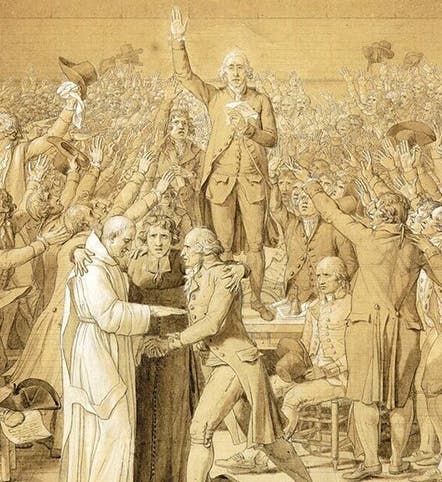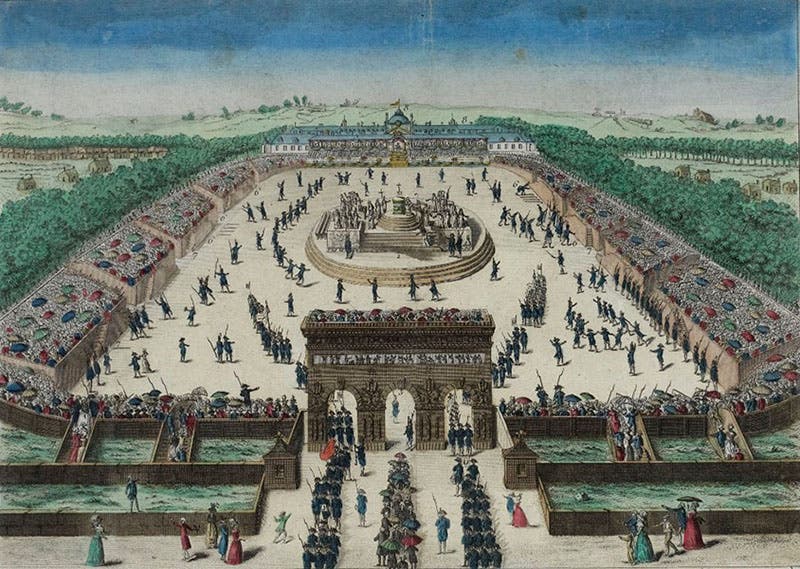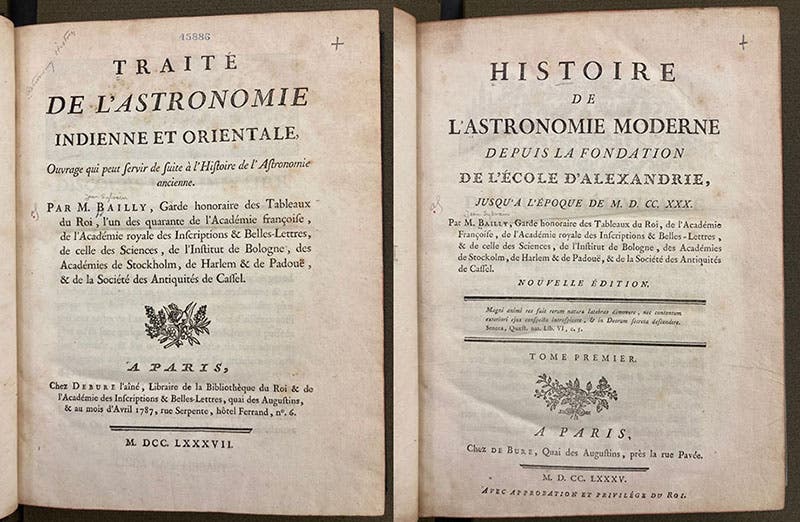Scientist of the Day - Jean-Sylvain Bailly
Jean-Sylvain Bailly, a French astronomer, was born Sep. 15, 1736. Bailly was one of the first historians of astronomy, writing volumes on the history of ancient astronomy, on the development of modern astronomy, and on Indian and Oriental astronomy, all of which were published between 1775 and 1787 and which we have in first or revised editions in our History of Science Collection. But Bailly turned to political life in 1789, becoming one of the leaders of the French Revolution. He was elected Mayor of Paris and presided over the famous Tennis Court Oath, June 17, 1789, when the Revolution began in earnest. In a drawing of the taking of the oath, made by Jacques-Louis David as a preparation for a monumental painting that was never finished, Bailly is the man on the platform, with his hand raised, leading the oath, and looking out at the viewer.
The unfinished canvas, which is huge (4 x 6 meters), hangs at Versailles. David never finished the painting, because by the time he was ready to move from sketch to painting, most of the heroes he had portrayed in the sketch had become villains, including Bailly. David (whom we profiled two weeks ago, as portraitist of Antoine Lavoisier and Napoleon), at once discovered the power of political painting, and the problems it encounters when the winds of state change course.
Bailly served as mayor of Paris for two years, 1789-91, and presided over the first Bastille Day celebration on July 14, 1790, on the Champ de Mars (third image). The next year, however, Bailly attempted to suppress a riot in the same public park; the rioters returned in larger numbers that day, and the national guard (led by the Marquis de Lafayette) fired on the crowd, with casualties amounting to somewhere between a dozen and fifty. The radicals were infuriated and blamed Bailly, who had to resign and leave Paris. Two years later, when Bailly attempted to visit Pierre Simon Laplace, he was recognized and arrested. He was summarily brought before the Revolutionary Tribunal and sentenced to death by guillotine, which took place just two days later. He was purposely executed on the site of the rebellion he had quashed, so on Nov. 12, 1793, his head rolled onto the Champ de Mars, not too far from the spot where, 10 years earlier, in a quite different world, Jacques-Alexandre Charles had launched his first hydrogen balloon, and the cheering had been much more innocent.
The books by Bailly that we have in our collection are: Histoire de l'astronomie ancienne, depuis son origine jusqu’à l'établissement de l'école d'Alexandrie (1775; we have the 2nd ed, 1781); Histoire de l'astronomie moderne depuis la fondation de l'école d'Alexandrie, jusqu'à l'époque de M.D.CC.XXX (1782; we have the 1785 ed. in 3 vols.); Lettres sur l'origine des sciences, et sur celle des peuples de l'Asie (1777); and Traité de l'astronomie indienne et orientale, ouvrage qui peut servir de suite à l'Histoire de l'astronomie ancienne (1787). They are not rich in graphics, so we show two of the titlepages above.
Dr. William B. Ashworth, Jr., Consultant for the History of Science, Linda Hall Library and Associate Professor emeritus, Department of History, University of Missouri-Kansas City. Comments or corrections are welcome; please direct to ashworthw@umkc.edu.









